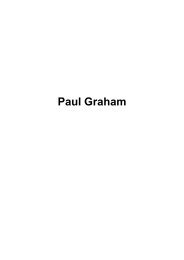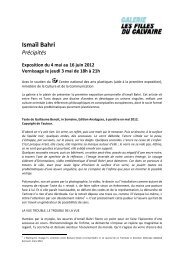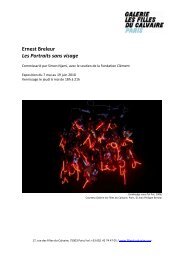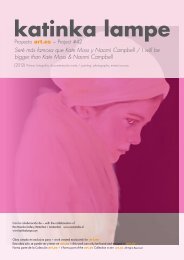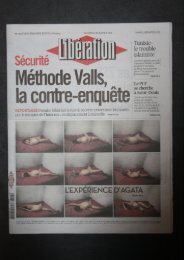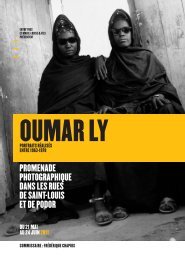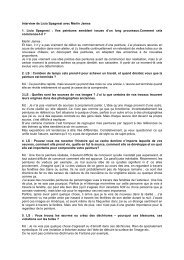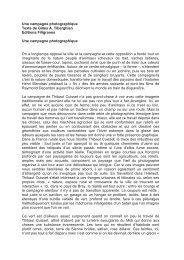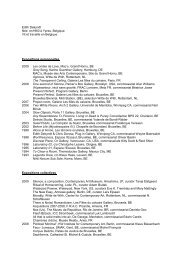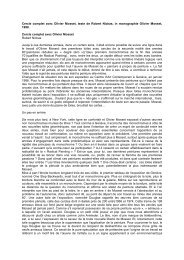Emmanuelle Villard : skin-deep painting Larys Frogier - Galerie Les ...
Emmanuelle Villard : skin-deep painting Larys Frogier - Galerie Les ...
Emmanuelle Villard : skin-deep painting Larys Frogier - Galerie Les ...
Create successful ePaper yourself
Turn your PDF publications into a flip-book with our unique Google optimized e-Paper software.
<strong>Emmanuelle</strong> <strong>Villard</strong> : <strong>skin</strong>-<strong>deep</strong> <strong>painting</strong><br />
<strong>Larys</strong> <strong>Frogier</strong><br />
Audacity :<br />
-<strong>painting</strong> today<br />
-working on the sense(s) - sêma/soma - through abstract art<br />
-assuming a share of femininity within a pictorial history governed by a scopic male<br />
stucture.<br />
The touching part of <strong>Emmanuelle</strong> <strong>Villard</strong>’s work lies in its double invitation: an admission to<br />
the trials and aesthetic jubilation of <strong>painting</strong>, and, at the same time, the opening up of<br />
abstract <strong>painting</strong> to contemporary problematics-image consumption, the body, intimacy,<br />
femininity…Whilst many contemporary artist are plunging themselves into photography and<br />
video, tending towards intimate exhibitionism or spectacular representation of the body,<br />
<strong>Emmanuelle</strong> <strong>Villard</strong> prefers to weave the surface of her canvas with possible ornaments or<br />
physical irregularities, questioning the validity of <strong>painting</strong> today, stimulating feminine<br />
evolution in life and artistic creation.<br />
If <strong>Emmanuelle</strong> <strong>Villard</strong>’s <strong>painting</strong>s seem exuberant and are undeniably generous, the artist<br />
works hard behind the scenes in the solitude of her studio. It takes time to create and think<br />
<strong>painting</strong>. In the studio, a table has replaced the easel. It is not however a question of radical<br />
horizontality occupying the ground, but rather a device whereby the painter, her body bent<br />
over the table and the canvas, has a limited, sometimes restricting, surface at her disposal,<br />
where she can perform meticulous gestures and an often repetitive motif. This particular<br />
body posture is not anecdotal. It may indeed have something in common with that of<br />
seamstress involved in some laborious task, but, in any case, it fully participates in<br />
determining the pictorial form.<br />
The painter’s inventiveness appears at the heart of the pictorial process, that’s to say, in the<br />
“how it’s done”: careful selection of colors, quasi-culinary mixture of paints and resins,<br />
recovery of paint-leftovers, declination of precise movements, spreading, tracing or dripping<br />
the paint onto the canvas, anticipation and discovery of the effects of the paint as it driescoagulation,<br />
shifting, cracks, thickening.<br />
Description alone of how the work is created, however, is not enough. Regarding Robert<br />
Ryman’s critical comments on <strong>painting</strong>, Yve-Alain Bois pointed out: “As in the past, the hunt<br />
for sources in literary studies, or the such for the true motif in History of Art(…), the account<br />
of the process establishes a primary meaning, an ultimate, founding referent, and blocks the<br />
chain of interpretation” 1 .<br />
Like Ryman’s white <strong>painting</strong>s, <strong>Emmanuelle</strong> <strong>Villard</strong>’s multicolored <strong>painting</strong>s thoroughly and<br />
rigorously explore <strong>painting</strong>’s infinite possibilities. They may indeed catch the art critic out<br />
who, wishing to perform a legitimate but systematic decoding of “how it’s done”, in fact turns<br />
the process into the sole causality of the <strong>painting</strong>’s existence.<br />
In order to find the beginnings of a way out of this impasse on process, let’s note, at this<br />
point, that the artist is neither trying to dominate her subject, nor control the materials. Great<br />
precision is certainly required throughout the development of the work, but so also the<br />
acceptance, together with an opening for possible reactions and transformation of pictorial<br />
matter and for doubts that permit the paint a certain laisser-faire, allowing the work to take<br />
shape.Over<strong>painting</strong>…<br />
On the other hand, the painter’s gesture and the paint’s possible torments have nothing to do<br />
with the heroic affirmation of an expressive body language. <strong>Emmanuelle</strong> <strong>Villard</strong> forestalls all<br />
painter’s narcissistic pathos, favouring minimal gestures, finicky, obsessional and repetitive.<br />
Gilles Deleuze has shown perfectly how repetition can constitute an act of resistance to logic<br />
1 Yve-Alain Bois, « le tact de Ryman », in cat. Robert Ryman, Paris : Centre Georges Pompidou,<br />
1981, p.11.
of narrative image consumption. 2 <strong>Emmanuelle</strong> <strong>Villard</strong> repeats, on the same and different<br />
canvases, the same gestures and the same motif. Repetition is carried out by juxtaposition,<br />
placing side by side, but also by superposition, covering, overflowing, or again, drawing lines.<br />
Repetition does not create identical <strong>painting</strong> but engenders differences by tracing zones and<br />
streams of perspective intensities.<br />
No one can escape the seduction in Emmannuelle <strong>Villard</strong>’s work. Her <strong>painting</strong>s, flashy and<br />
colorful, produce a shop-window effect, like sweets-shop or clothes shop windows or stalls at<br />
a fair, which accidentally the artist enjoys photographing. Unless it is a case of <strong>painting</strong> as<br />
one puts on make-up, of considering paint as a surface device and ornament. Or again, of<br />
consuming the <strong>painting</strong>s as one would consume seemingly appetizing cakes: if our eye was<br />
a tongue, we would often find <strong>Emmanuelle</strong> <strong>Villard</strong>’s <strong>painting</strong>s a little too sweet. Were<br />
therefore does this sickly sweet taste that remains in our eyes come from?<br />
Speaking of seduction we cannot avoid the question of femininity in Emanuelle <strong>Villard</strong>’s work.<br />
In fact, if on agrees that her <strong>painting</strong> seduces by its ornaments and its shimmering colors,<br />
one might be tempted to declare that, in that, it is feminine.<br />
Such an interpretation however is extremely reductive, insting even, since it only reproduces<br />
a fetishist vision of the works and encloses femininity within the stereotype of a beautiful<br />
object to be admired. The femininity assumed in Emanuelle <strong>Villard</strong>’s work, is never dupe to<br />
its power of seduction. Her <strong>painting</strong> is seductive in that it is deceitful. It would first deceive<br />
itself, intentionally, as if to dismiss any enclosure of <strong>painting</strong> within the fascination of its sole<br />
autonomy and creation process. The rendering of the <strong>painting</strong> with its multicolored, flashy<br />
surface comes almost as if to make the repetitive gestures and its rigorous, laborious<br />
creation vanish. Colour as a travesty or masquerade of the <strong>painting</strong>’s elaboration process.<br />
Fundamentally, <strong>Emmanuelle</strong> <strong>Villard</strong>’s <strong>painting</strong> comes to deceive the viewer’s eye, which is<br />
instantly caught and absorbed by the conjugation of colors. But the <strong>painting</strong> later reveals that<br />
this surface effect is really carnal. The work’s seductive effects are in fact metaphors for <strong>skin</strong>,<br />
declined and stratified in different states: certain <strong>painting</strong>s like the» pies”, bring to mind <strong>skin</strong><br />
that has been overly made-up, whilst the “goosepimple”series inevitably evokes damaged<br />
and blistered <strong>skin</strong>, or again, other <strong>painting</strong>s, like the» netting” series, blur the effect of <strong>skin</strong><br />
squeezed into stockings or chirurgical gauze.<br />
One begins to see how such <strong>painting</strong> maintain an essential link with <strong>skin</strong>, not as a simple<br />
surface or envelope, but as a real place of exchange, transformation and contact. Between<br />
the paint pot and the epidermal deposit of paint on canvas, between matter and pictorial<br />
form, carnal interstices develop that permit the rubbing of one matter against another, the<br />
shifting of one from towards another, the moving of one <strong>painting</strong> towards another, the<br />
passage from external to internal, interchangeable habitation of identity envelopes. These<br />
however are only the effect of paint with no representational claims. But this anatomical nonrepresentation<br />
leads to infinite tussles, mixing suppleness, density, fragility, consistency and<br />
the emergence of shapeless matter.<br />
If indeed it were necessary to find a historical reference, there is no need to look to historical<br />
figures in <strong>painting</strong>. I am thinking in particular of one of Hannah Wilke’s works, Starification<br />
object series (SOS)-1974-1982- which is a panel of ten photographs where the artist can be<br />
seen, stripped to the waist, adopting different poses and masquerades of femininity( femme<br />
fatale, woman-child, prostitute…) Except that Hannah Wilke’s face and body are dotted with<br />
small beads of colored rubber, like jewels or pustules, worked and modeled so as to suggest<br />
the lips of a female sex organs. This work from the seventies was audacious in that it took<br />
the opposite stance to a feminist militancy, hostile to all representation of femininity, and<br />
turned feminine seduction around into a vehicle for social criticism rather than a process of<br />
male fetishisation of the female body. This turnaround was made possible stratification and<br />
layering in the representation of the female body: body-matter, masculine/feminine clothing,<br />
2 Gilles Deleuze, Répétition et différence, Paris : Presses Universitaires de France, 1968.
the naked bust, the pose, rubber beads, the symbol of the female sex organs, photographic<br />
images in series. 3<br />
With <strong>Emmanuelle</strong> <strong>Villard</strong>’s <strong>painting</strong>, it is no longer necessarily a question of representing a<br />
feminine/feminist body, but rather of playing, over the entire surface of the canvas, with the<br />
effects of strata and matter, echoing female flesh. Femininity asserted in her work is<br />
therefore a strategy of infiltration into <strong>painting</strong> and its history, as well as an effective and<br />
subversive strategy for seducing the eye. It is not simply a question of looking pretty and<br />
flashy, but of repeating and exploring the attributes of supposedly feminine genre, right to the<br />
end. To such a degree that this repetition has come to undo a double myth: that of femininity<br />
as a simple, external envelope and that of <strong>painting</strong> as a single flat surface; the function of<br />
these two myths being to produce a fetish intended strictly for scopic pleasure. Femininity at<br />
play in <strong>Emmanuelle</strong> <strong>Villard</strong>’s work arises out of its many layers, its composition in thick strata,<br />
subtle links, artificial films, glitter, glossy colors. It is these layers that permit cracks, shifting<br />
of matter and meaning. Feminine evolution in <strong>painting</strong> is, definitively, this cat of diverting and<br />
transforming the eye.<br />
<strong>Larys</strong> <strong>Frogier</strong>,<br />
In act, <strong>Emmanuelle</strong> <strong>Villard</strong> /17 th January-1 st march 2002/<br />
La criée centre d’art contemporain (Rennes),p.6.<br />
3 For a study of Wilke’s work see Amelia Jones, « The Rhethoric of the pose : Hannah Wilke and the<br />
Radical Narcissism of feminist Body Art », in Body Art : Performing the subject, Minneapolis :<br />
University of Minnesota



